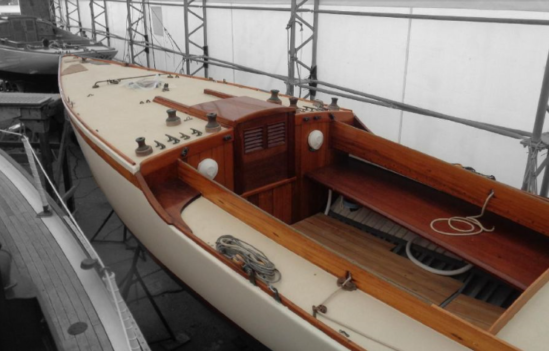
Sail Number: 14
Type: Victory Class
LOA: 31’8″ / 9.69m – LWL: 20’8″ / 6.33m – Beam: 7’0″ / 2.13m – Draft: 4’10” / 1.24m – Hull Number: – Designer: William Gardner – Original Owner: H. M. Curtis – Current Owner: – Year Built: 1920 – Built By: Henry B. Nevins Shipyard, City Island N.Y – Hull Material: Wood – Gross Displacement: 5,885 lbs – Former Name(s): White Lady, Vindictive – Rig: Marconi Rigged-Sloop – Location: Portsmouth, RI – Status: For sale (2019)
Historical:
Junius Spencer Morgan III, of West Island, Glen Cove, New York, the son of J. P. Morgan, the renowned financier, was instrumental in forming the Victory Class the year after World War I in the fall of 1919. Twenty yachtsman came forward through his efforts to build the vessel at Henry B. Nevins Shipyard in City Island N.Y. Launched in May of 1920, the raised fore-deck marconi rigged sloop proved to be a very fast dry capable yacht.
The class was formed to revive the sport of yachting after World War I with an affordable one-design class. They were named Victory-class in tribute to the yachtsmen who participated in World War I. Each boat was originally named after a phase of or reference to the war.
Construction
Built by the Henry Nevins Yard in City Island, NY out of steam bent, oak frames with cedar planking, MONGOLIA has been very well maintained. Her keel was dropped and rebedded after the deadwood and keel timber were redressed, and the keel boats inspected (they were as new). A new rudder was installed and the hull glassed and faired on the outside from the cove strip down over the lead keel joint before the hull was repainted. The interior and bilge area were cleaned and painted. The cockpit floor was replaced and seats supports refurbished. A new, longer tiller was also added.
Wooden mast and boom were stripped and varnish built up. The leather was replaced on stay loops and wooden blocks and all running rigging replaced. There a six winches to ease of sail handling. The sails were replaced.

Victory Class Sloop (Original 20)
*Ace – Adrian Iselin Jr (World War I flying aces)
A. E. F. E. G. – Potter
Alerte – Robert W. Martin (the sound of sirens during air raids) Status lost in Galveston Bay during a storm and was scrapped during Word War II.
Arethusa – C. D. Norton (HMS Arethusa was the name ship of her class of eight light cruisers built for the Royal Navy in the 1910s. She saw a considerable amount of action during the early years of the First World War, participating in the Battle of Heligoland Bight and the Battle of Dogger Bank.)
Black Jack – H. S. Morgan (John Joseph “Black Jack” Pershing (September 13, 1860 – July 15, 1948) was the general in the United States Army who led the American Expeditionary Forces to victory over Germany in World War I, 1917–18.)
Blue Devil – Howard Whitney (The 88th Infantry Division was a unit of the United States Army in World War I)
Blue Jacket – James B. Ford (The Bluejacket’s Manual is the basic handbook for United States Navy personnel.)
Bois de Belleau – F. R. Mayer (the battle of Belleau Wood, June 1918, the most important battle fought by US forces since the US Civil War.)
Buddy – Carroll B. Alker
Briquette – John T. Pratt (The compaction of loose combustible material for fuel making purposes, used commonly during World War I.) Status lost in Galveston Bay during a storm and was scrapped during Word War II.
Cantigny – Dr. C. I. Atkinson (The Battle of Cantigny, fought 28–31 May 1918, was the first American battle and offensive of World War I.
Carry On – Wm. H. Appleton
Gopher – F. W. Hine
Mary Rose – J. S. Morgan, Jr (HMS Mary Rose, launched on 8 October 1915, was an Admiralty M-class destroyer . sunk on 17 October 1917 approximately 70 miles east of Lerwick while escorting a convoy of 12 merchant ships from Norway.)
Mongolia Mongolia – H. M. Curtis (December 29, 1911 the Mongols declared their independence from the collapsing Qing dynasty following the Xinhai Revolution.)
Naviator – F. Trubee Davison
Nieuport – R.A. Brown (French bi-plane fighter)
Otranto – R. B. Meyer (the 1917 Battle of the Strait of Otranto)
Soixante-Quinze – Swan & Stewart (field gun used in World War I by the American Expeditionary Forces, French for 75)
Spad – Harold I. Pratt (named in honor of a World War I bi-plane) Was last known to be sailing in Galveston Bay well into the 1970’s.
* Ace was originally built for Sherman Hoyt, but Mr. Hoyt was on board Vanitie, so was sold to Mr. Howard L. Curry for his son Gordon Curry
The Victory Class was governed by strict rules, Four persons allowed, but no paid hands. The boats were allowed to be hauled, but once in three-weeks, and not more than 48 hours. One suit of sails a season, and a detailed list of equipment must be carried, and no changes to lead ballast, and spar dimensions.
Provenance (The Wall of Remembrance – The Owners, Crew & Notable Guest):
- Owner/Guardian: Lynton Gardiner
- Owner/Guardian: (2014) – Thorpe Leeson
